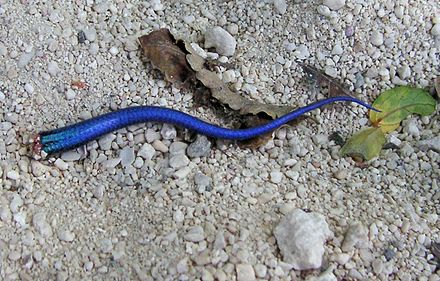
Be Golden as gold mine & Green as leaf
carpe diem
Be Golden as gold mine & Green as leaf
carpe diemTail regeneration after autotomy revives survival: a case from a long-term monitored lizard population under avian predation

Autotomy, the voluntary shedding of an appendage to evade entrapment [1], is perhaps the most dramatic and energetically costly anti-predator behaviour in animals. It has been observed in diverse animal taxa including both invertebrates and vertebrates that detach a variety of body parts [2–8]. In addition to the well-known immediate survival benefit of this tactic, the costs to the individual after detachment have also received much attention in recent decades, which has increased our understanding of the cost–benefit dynamics of autotomy and its evolutionary trajectory [2,7,8].
Caudal autotomy in lizards is perhaps the most famous case of a body-shedding tactic, and it has intrigued scientists for over 100 years [3,9,10]. Species from at least two-thirds of lizard families have the capability to lose and regenerate their tails [11–13]. During this process, contracting muscles split the weak structure of the tail vertebra, which causes the tail to separate from the body and enables the lizard to flee from the grip of a predator [6]. The post-autotomy tail acts as a distraction that writhes and wiggles to draw the attention of the predator away from the owner of the tail [6,14,15]. Many previous studies have shown that tail autotomy could increase the immediate survival rate when lizards encounter predators [16–18], and subsequent studies also suggested that the risk of predation might enhance the evolution of autotomy [19–21].
Despite the long-term interest in tail loss in lizards, some issues remain the subject of debate. First, the degree of association between the frequency of caudal autotomy and predation pressure under natural conditions is controversial. In recent decades, researchers have debated the ecological relevance of autotomy rate in the wild as follows: does it reflect the real predation pressure? Or does it reflect predation ‘inefficiency’ ([22–24], reviewed in [13])? The inconsistent results concerning the relationship between the field autotomy rate and predation pressure [20,21] reveal that the debate is ongoing. As the field autotomy rate of lizards is influenced by the temporal and seasonal fluctuations of the abundances of multiple predators, the association between field autotomy rate and predation pressure would be obscured if researchers only focus on a short timescale. Surprisingly, long-term studies of autotomy in lizards are extremely rare.
Second, although the costs of tail loss and regeneration have been well studied in captivity, the long-term consequences have been less well explored in the wild [3,8]. Many studies have documented the intrinsic impacts of tail loss, including energetic impairment [25–27], decreased agility and/or activity ([28–30] reviewed in [31]), and the loss of the opportunity to shed the tail in a subsequent predatory encounter [12]. All of these factors are assumed to contribute to the ultimate cost—a decline in mating success [32–34] and survival [12,26,35]. Nevertheless, most studies that were performed in the laboratory or within artificial or semi-natural environments only showed an effect for a short time following tail loss. Only a handful of studies have focused on the long-term consequences of autotomy in the wild, particularly as they relate to survival. The rarity of field studies and their inconsistent results have perpetuated the ambiguity of the long-term costs of tail loss. For example, the contradictory results from studies of Uta stansburiana (positive evidence in [26,35] but not in [25,36]) indicate that understanding the long-term effect of autotomy on survival remains elusive.
Similar to autotomy, the long-term consequences of regeneration have also rarely been addressed. Regeneration is an energetically expensive process that could exert serious costs on an individual, but this trait is widely maintained in a variety of squamata taxa, which hints at the potential benefit of this strategy. The adaptive hypothesis of regeneration [7] predicts that the regrowth of a shed structure could alleviate the survival cost of autotomy, but little is known about this benefit following regeneration under natural conditions.
Field demographic studies over a long timescale provide a straightforward solution to these debates. In this study, we conducted a 7-year capture–mark–recapture (CMR) experiment on a wild population of the sexually dichromatic green-spotted grass lizard, Takydromus viridipunctatus. Members of the genus Takydromus are ‘grass swimmers’ with an elongated body shape and an extremely long tail (2.5–4.2 times the snout–vent length (SVL), depending on the species [37,38]). These lizards inhabit open grasslands and exhibit a unique sleeping behaviour in which they perch almost exclusively on the long, soft, thin leaves of Miscanthus or other Gramineae grasses. This behaviour is believed to prevent predation by rodents, shrews, and serpents from the ground at night. These lizards are usually non-territorial, forming extremely high population densities in suitable microhabitats with no pronounced male–male competition [39–41], limiting the potential for intraspecific interactions to result in tail loss. Finally, sympatric owls (Otus spp.) have never been observed to prey on this lizard. All these observations support the conclusion that diurnal birds are likely the major predators contributing to green-spotted grass lizard mortality and tail loss (electronic supplementary material, figure S1).
In this study, we incorporated data on lizard survival and caudal autotomy with the data on contemporary dynamics of four major bird predators from a national bird watching mega-dataset. Our objectives were to (i) inspect predator abundance versus lizard tail loss and survival rates to determine the relationship between field autotomy and predation efficiency, (ii) estimate the survival rates of tailed and tailless individuals to understand the long-term consequences of autotomy on survival, and (iii) examine the alleviation of the survival cost of autotomy through tail regeneration to determine the benefit of this evolutionary tactic. With more than 20 000 captures of more than 11 000 individual lizards over the past several years, this is one of the first long-term studies of the cost–benefit relationship of tail autotomy and regeneration in the wild
the information is given from:https://doi.org/10.1098/rspb.2016.2538